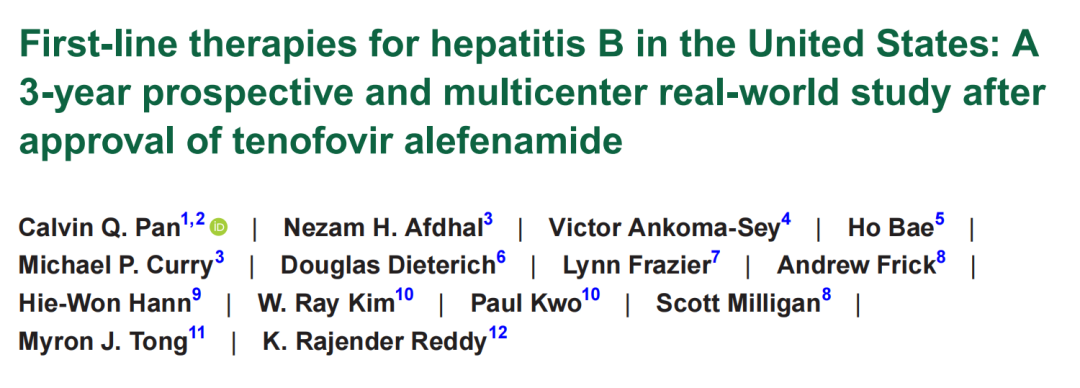From the latest real world research, look at the status quo of CHB's front -line treatment | cutting -edge insight
Author:Digestive liver disease channe Time:2022.07.07
For medical professionals for reading reference

In clinical diagnosis and treatment, the actual use of the first -line NA
Realizing the response and continuous inhibitory virus replication are the key to prevent chronic hepatitis B (CHB) to the progress of liver cirrhosis or liver cells (HCC) [1]. Therefore, in CHB management, antiviral treatment is particularly important.
Powerful, low-resistant pomolic acid glycoloholinohovir (TAF), Fogaolinolin (TDF), and Entica (ETV) are currently the first-line anti-anti-recommendation of major guidelines [1-3] Virus treatment drugs.
Compared with ETV and TDF, TAF has a relatively short application time in clinical practice, but more and more TAF real world data has emerged, verifying its efficacy and security. In 2016, the United States established the Trio HBV network to understand the treatment of hepatitis B virus (HBV) in the real world. Recently, the Trio network data published the full text on Hepatology Communication (Figure 1). After observing the TAF approval, CHB patients' changes in the choice Evaluation [4].

Figure 1 Thesis Homepage Screenshot
This multi -center, observation, forward -looking, retrospective research finally included in 889 cases in November 2016 [TAF was approved by the US Food and Drug Administration (FDA)) to adult patients who were diagnosed as CHB from January 2017 to January 2017 Essence All patients have to conduct HBV virus detection when they enter the group, and complete the follow -up of at least 24 months after the group, with an average follow -up time of 35 months. The main end of the study was the choice of antiviral therapy drugs and conversion therapy for patients with CHB patients throughout the follow -up period. The secondary end point is the efficacy and safety of first -line therapy drugs. Evaluation indicators include the normal rate of virus response (HBV DNA ≤20 IU/ml), a vertical aminotransferase (ALT), the progress of the disease, and the incidence of laboratory adverse events. Essence
As can be seen from the baseline data, most of the 889 patients (87%) are Asians, 72%(639/889) are HBEAG negative, with an average age of 52 (± 13). age. In addition, the common complications of the group include hypertension (23%), hyperlipidemia (13%) and diabetes (10%). In terms of antiviral drug selection, patients with TDF single drug treatment account for 63%(561/889), patients who receive ETV single drugs account for 25%(223/889), and only 1 patient who receives TAF single drug treatment is 1 %(12/889).
During the follow -up period, the use rate of TDFs was decreased from 63%to 30%, ETV's utilization rate decreased from 25%to 22%, while the TAF usage rate increased from 2%to 38%(Figure 2). In addition, compared with the treatment in the medical center, the proportion of patients receiving TAF treatment in the community center is significantly higher (25%vs.62%, P <0.001). Among the 389 patients who received TAF treatment, 83%(321/389) were converted from TDF to TAF treatment, 8%(31/389) converted from ETV to TAF treatment, and most of the reasons for converting treatment plans It is for security considerations. Logistic regression analysis showed that HBEAG positive (OR: 0.60, 95%CI: 0.39-0.93, P = 0.023) during the group was treated in community center (OR: 5.24, 95%CI: 3.53-7.90, P <0.001) It is an independent prediction factors converted to TAF treatment. In addition, in 229 patients who continued to maintain TDF treatment, 67 cases should be converted to patients with the recommendation opinion of the European Liver Society (EASL 2017) to be treated with TAF or ETV. [3] Example age is 60 years old and 10 patients with genagonia filtration (EGFR) <60ml/min/1.73m2 and 6 patients with osteoporosis].

Figure 2 During the follow -up period, the change of the treatment plan
Researchers further analyzed the efficacy and safety of first -line antiviral drugs including TAF. Among them, 187 cases, 229, and 181 patients each completed the 24 -month continuous treatment.
The results showed that among 187 patients who received TAF treatment, compared with the beginning of treatment, after 24 months of treatment, the response rate of the virus was significantly increased (86%vs.93%, P = 0.012), and the normal rate of ALT was also Higher (56%vs.66%, P = 0.031), other indicators such as EGFR, platelets, FIB-4 and Reach-B scores are not significantly different before and after treatment (all P values are> 0.05).
229 patients who maintained TDF treatment after 24 months of treatment, the response rate of the virus also increased significantly (80%vs.87%, P = 0.014), while the proportion of patients with <60 ml/min/1.73m2 of EGFR <60 ml/min/1.73m2 was significantly significant. Increase (4%vs.9%, P = 0.010).
Of the 223 patients who maintained ETV treatment, after 24 months of treatment, the response rate (P = 0.099) and the normal rate of ALT had no significant changes (P = 0.635), and the proportion of FIB-4> 3.25 increased significantly (5 %vs.8%, P = 0.041). In addition, EGFR has not changed significantly after 24 months (P = 0.683). The real world mainly based on Asians showed that in the process of clinical diagnosis and treatment, more and more CHB patients received TAF for antiviral treatment based on the effectiveness of TAF antiviral effects and consideration of the safety of patients. TAF has accumulated more real world data. In addition, in this study, patients after the conversion of TAF treatment are more advantageous than continuing to maintain ETV and TDF treatment than continuing to maintain ETV and TDF treatment. The results of this study further verified the efficacy and safety of TAF in real world practice, and also provided more favorable evidence -based medical evidence for TAF therapy CHB patients.
references:
[1] Wang Guiqiang, Duan Zhongping. Chronic hepatitis B prevention and control guide (2019 edition) [J]. Liver, 2019,24 (12): 1335-1356.
[2] Terrault n a, Lok a s f, mcmahon b j, et al.Update On Prevention, Diagnosis, and Treatment of Chronic Hepatitis B: Aasld 2018 Hepatitis B Guidance [J] .hePatology, 2018,67 (4) 1560-1560-1560:
[3] EUROPEAN Association for the Study of the Liver.easl 2017 Clinical Practice Guidelines on the Management of Hepatitis B Virus Information [J] .journal of Hepatology, 2017.7,7.7,777 (2) (2).
[4]Pan CQ,Afdhal NH,Ankoma-Sey V,et al.First-line therapies for hepatitis B in the United States:A 3-year prospective and multicenter real-world study after approval of tenofovir alefenamide.Hepatol Commun.2022 APR 21.
- END -
[Psychological Health] During the prevention and control of the epidemic prevention and control, the psychological instructor team of Zhengzhou City Bureau provides psychological support for the overall police

Psychological instructors carry out health counseling for the police of the Jinshu...
Ganzhou, Jiangxi: Mathematical Tumor Standardized Diagnosis and Treatment Patrol Lecture Grassroots to help tumor prevention and control

Text 丨 Xiao WeihuiIn order to further strengthen the management of tumor diagnosi...